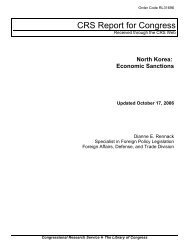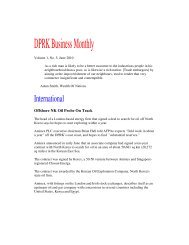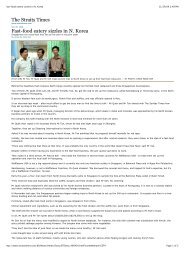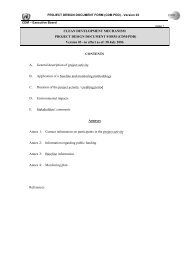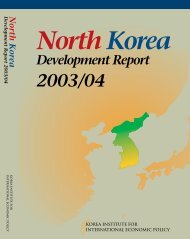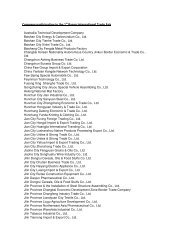North Korean Policy Elites - Defense Technical Information Center
North Korean Policy Elites - Defense Technical Information Center
North Korean Policy Elites - Defense Technical Information Center
You also want an ePaper? Increase the reach of your titles
YUMPU automatically turns print PDFs into web optimized ePapers that Google loves.
The Guard and Security Commands, while institutionally subordinate to the MPAF, are<br />
controlled by the State Security Department. <strong>Information</strong> and intelligence produced by these<br />
Commands serve as a check to that produced by the KWP’s General Political Bureau and are<br />
believed to flow upward through both the MPAF and the State Security Department. Both the<br />
Guard and Security Commands possess small SIGINT components, which are apparently<br />
focused upon internal targets. The level of computerization within these Commands is believed<br />
to be high.<br />
The Reconnaissance Bureau is the primary military intelligence agency within the DPRK.<br />
As such, it utilizes a wide array of methods to collect relevant information and process it into<br />
intelligence, which is then disseminated to varying degrees among the components of the MPAF<br />
and General Staff Department, as well as the National <strong>Defense</strong> Commission. The Internet and<br />
foreign media apparently serve as important sources of information for the Reconnaissance<br />
Bureau.<br />
With regard to information access and dissemination, the Reconnaissance Bureau’s<br />
<strong>Technical</strong>/Radio Department plays a crucial role. This Department, in cooperation with the<br />
Electronic Warfare Bureau, is believed to be the organization exercising overall responsibility<br />
for SIGINT, communications security (COMSEC), EW, and EIW operations within the MPAF.<br />
The number and organization of SIGINT assets within the MPAF is unclear. Ground based<br />
assets are believed to consist of a small number of independent SIGINT collection sites located<br />
throughout the DPRK in areas of high interest (e.g., along the DMZ and the Russian and PRC<br />
borders); the EW/SIGINT battalions within KPA corps; and the EW/SIGINT battalions that exist<br />
within some KPA divisions. In addition to these assets, the <strong>Technical</strong>/Radio Department<br />
exercises some degree of control over KPAF SIGINT collection aircraft and KPN intelligencegathering<br />
vessels (AGIs). Assets subordinate to the <strong>Technical</strong>/Radio Department are responsible<br />
for EIW operations. The Department also coordinates with the MPAF Communications Bureau<br />
and its subordinate units. The relationship and level of coordination and cooperation between the<br />
Reconnaissance Bureau’s <strong>Technical</strong>/Radio Department and the State Security Department’s<br />
Communications Interception Bureau is unknown. The Communications Interception Bureau is<br />
apparently the senior service. The Reconnaissance Bureau and the State Security Department are<br />
believed to be the principal agencies involved in the production of regular translations of foreign<br />
broadcasts. These apparently are disseminated with varying levels of access to the military and<br />
power-holding elite.<br />
As with the State Security Department, the level of computerization within the<br />
Reconnaissance Bureau is believed to be high, with numerous modern desktop and mid-range<br />
computers, the vast majority of which are of Asian manufacture. The availability of Internet<br />
I-22



